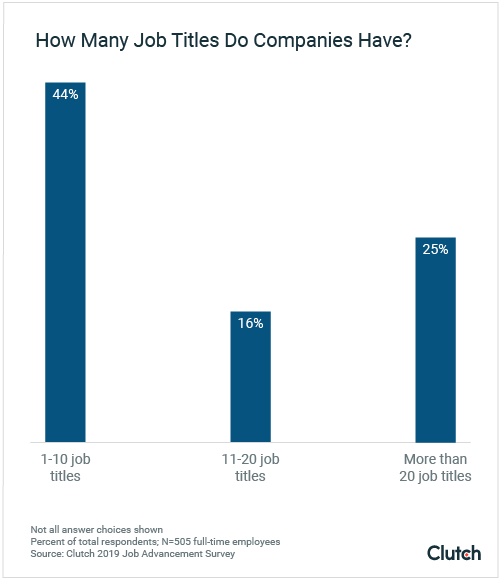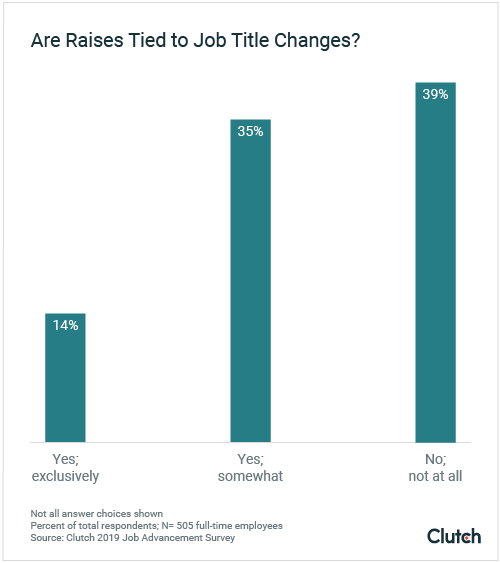

Updated December 16, 2024
Providing the job titles that accurately describe workers’ roles are key to creating a fair workplace environment, according to our survey of 505 full-time U.S. employees. Businesses should plan to introduce more job titles as they add employees and ensure their job titles accurately reflect employees’ tasks and responsibilities.
Updated March 16, 2022
Imagine you’re looking for a new job: how do you know what you are qualified for? What transferable skills do you have? How much money should you be asking for to perform your job?
Looking for a Human Resources agency?
Compare our list of top Human Resources companies near you
Job titles — featured on job hunting platforms, mentioned by headhunters, and listed on company job boards — are the first indication of what a position entails.
What is a job title?
A job title is the name of a position within an organization or company. They’re associated with a job descriptions and can help employers and employees align on their roles, responsibilities, and expectations.
Job titles are incredibly important for employees and job seekers because they define company roles. While this may seem superficial, it actually has a huge impact on company hierarchy, salaries, credibility, and more.
In addition to outlining existing responsibilities, they can help employees feel like they’re progressing in their careers and are appreciated for their work. Recent studies have shown that many people value their titles and would go so far as to take a title change over a raise.
As a result, work titles can have a major impact on job satisfaction. People will resign and look for new opportunities if it means that they can get a new job title.
As more and more people are resigning from their jobs in the wake of the COVID-19 pandemic, outlining expectations and creating a fair work environment are more important than ever.
Because they’re so important to job seekers, they’re valuable for companies looking to attract and hire new talent.
Why Are Job Titles Important?
To understand more about how job titles affect workers' attitudes and their ability to execute their roles, we surveyed 505 full-time U.S. employees.
We discovered that companies rely on their job titles to demonstrate their organization's commitment to fairness and accuracy. Descriptive job titles that reflect employees' tasks and workloads are important for every company's success.
Job titles also help companies organize and define the expectations they have for each employee.
Looking for a great HR company to handle benefit plan management, recruiting, training, or payroll processing? Check out our directory of top HR outsourcing companies.
Companies should expect to introduce more job titles as they become larger and their employees' roles become more specialized.
About 44% of companies have between 1 and 10 job titles, including 31% with between 1 and 5.

Meanwhile, one-quarter of businesses (25%) have more than 20 job titles.
Experts say that companies are likely to have more job titles as they grow and evolve to reflect the different skillsets and responsibilities of their employees.
Tia Coward, events coordinator at Snap Events, an event-planning agency in Las Vegas, says that her job title does not represent every element of her day-to-day role, as she does not focus on event coordination only.
According to Coward, job titles at a 5-person company such as hers rarely summarize an employee’s full range of tasks and responsibilities because employees are expected to perform more tasks outside of their main role. At a larger corporation, marketing jobs, for example, are often broken into specific categories: A social media expert becomes a “social media manager,” a technical SEO marketer is called an “SEO specialist,” and an employee who stages events is an “event coordinator.” Since roles at larger companies are more specialized, such job titles usually do summarize employees' full roles.
Because her agency is smaller, Coward understands that she is expected to have a hand in all aspects of marketing, even though her job title does not indicate it.
With increased company size comes increased employee specialization, so companies should be prepared to introduce more job titles as their business expands.
Businesses should give employees job titles that summarize their primary role, which will keep employees productive, satisfied, and effective.
Nearly two-thirds of employees (64%) say that if two workers have the same job title at their company, there is generally little to no difference in the daily tasks they complete.

To experts, it is vital that companies outline employees’ typical tasks in their job title descriptions.
“Job titles should reflect the position they represent,” said Mike Golpa, director of G4 by Golpa, a precision implant dentistry. “Think of the job title as a miniature summary of the job. It should tell you what they do before you even get to the description.”
For example, Golpa says that a “purchasing manager” should spend most of his or her time at work obtaining products and services. A “social media manager” should primarily focus on managing a company’s social media, not designing an internship program or pitching stories to journalists.
For smaller companies, providing a job title that recaps daily responsibilities is more challenging because employees likely have a range of responsibilities.
Coward says that job titles are vital to effectively engaging with clients and other contacts outside the company.
“The most important thing to me as an employee is that my job title reflects what a potential client or contact would expect."
“The most important thing to me as an employee is that my job title reflects what a potential client or contact would expect from someone reaching out to them about planning an event,” Coward said. “It wouldn't make as much sense for a ‘social media manager’ to be asking [a client] to book a 3-day, $1,000 event.”
Coward’s job title may not reflect all of her tasks, but it does emphasize her primary expectation: coordinating and conducting event-planning.
Companies can keep their workforce happy and effective by ensuring their job titles represent employees’ primary tasks and responsibilities.
People want to be treated fairly at work, so companies must provide their employees with job titles that honestly represents the workload they have.
Employees prefer workers with the same title to hold the same level of responsibility, which is the accountability and control employees hold over themselves and, sometimes, others.
Two-thirds of people (66%) say it is very or somewhat important for two employees with the same job title to have the same overall responsibility at work.

Meanwhile, fewer than 2 in 10 employees (16%) say that it is not at all important for employees with the same title to have similar workloads.
Businesses should consider the difference between tasks and responsibilities:
For example, two employees may complete similar tasks, but if one is also responsible for guiding the work of others, the two employees have different levels of responsibility.
To account for this difference, businesses should give the two employees different job titles.
John Moss, CEO of English Blinds, a window blinds supplier, says employees should be rewarded with a new job title that highlights additional responsibilities when they receive them.
“Simply designating someone’s title as ‘senior’ can reflect the added experience and responsibilities, ensuring that they feel their work is acknowledged, respected, and appreciated.”
“Simply designating someone’s title as ‘senior’ can reflect the added experience and responsibilities, ensuring that they feel their work is acknowledged, respected, and appreciated,” Moss said.
At his own company, Moss now refers to supervisors who manage other supervisors as “senior supervisors,” in comparison to the “general supervisors” who manage projects and teams but not other employees in management.
By making simple but obvious efforts to factor employees’ responsibility into their job titles, businesses such as Moss’ satisfy employees and make their own organizational structure clearer.
Even if responsibility is factored into employee job titles, some employees are bound to believe they hold more responsibility than others in the same position. For example, more than one-quarter of men (26%) say they have more responsibility than all other employees with the same job title.

Only 18% of women share the same sentiment.
To experts, men’s heightened likelihood of believing they have more responsibility than their peers is a reflection of broader workplace issues, including:
Broadly, experts believe that employees have a tendency to overestimate their own level of responsibility while underestimating the contributions of their co-workers.
"I've always felt that people, in general, will exaggerate how much work they have on their plate, as society seems to equate those with a lot on their plate to those with strong work ethics," said Garret Seevers, vice president of marketing at Azuga, a fleet tracking services company. "I also feel like it's easier to downplay somebody's role in something until you are the one actually working in that same role later on down the road."
Descriptive, accurate job titles and descriptions help employees avoid downplaying other people's roles and responsibilities.
Some workers think their title fails to represent their work, demonstrating that companies should determine an employee’s job title only after deciding what his or her daily expectations and activities will be.
While 38% of employees say their job title very effectively describes their role at work, close to one-quarter of employees (23%) do not believe their job title effectively represents their daily work.

Coward says job titles tend to be different from employees’ actual roles when companies:
For example, someone starting a new job as a “marketing manager” may expect to write marketing copy and manage a marketing team. Some “marketing manager” jobs, however, primarily involve completing highly technical SEO strategies. An employee hired under the belief he or she will write marketing copy who ends up crafting technical SEO strategies is unlikely to be happy and effective.
By failing to tie a job title to an employee’s actual work, companies may create worker dissatisfaction because employees want to do the work their title suggests.
Employees should have pay raises tied to performance, not necessarily a change in job title.
Just 14% of employees say that their company only offers pay raises to employees when their job title also changes.

In comparison, 39% of employees say that pay raises are generally granted without a change in job title at their company.
Ladan Davia, founder and CEO of AI-driven job listing company Beeya, says she ties pay raises to performance, not an employee’s title.
“I don’t believe in the idea that just because a person doesn’t have a certain title means they aren’t eligible for a raise,” Davia said. “If they’re hitting their marks, being productive, making deadlines, and advancing the company, then that should be all you need to know.”
Beeya, which has six employees, has a chief technical officer (CTO) who is responsible for the research and development of the company’s software. Even though the department’s “C-suite” position is filled, the company’s other developers can still earn bonuses and pay raises if they perform their jobs well.
Offering pay raises based on performance, not job title changes, is especially important for credentialed employees.
For example, most employees at Golpa’s dentistry have pre-set titles and certifications earned through specialized training. Dental technicians, dental hygienists, and lab technicians cannot easily have their title changed each time their pay is raised to reward performance, longevity, or a cost-of-living adjustment.
Without a significant change in the job role, employers do not need to give workers a change in job title each time their pay is increased.
Job titles are important to the career growth of employees and to the organizational efficiency of companies. As a result, they're also incredibly important for companies looking to attract and retain talent.
Crafting job titles that provide employees a sense of internal purpose and external legitimacy is important for businesses large and small. By carefully summarizing a position's role and outlining how it fits into the larger organization, companies can increase satisfaction and help teams align.
By following these steps, companies will provide their employees job titles that help them grow as professionals and contribute to business success.
Clutch surveyed 505 full-time employees in the U.S.
Thirty-one percent (31%) work at organizations with 1 to 50 employees; 25% with 51 to 500 employees; 19% with 501 to 5,000 employees; and 25% with more than 5,000 employees.
More than half of respondents (55%) are female, and 45% are male.
Fourteen percent (14%) of respondents are ages 18-34; 54% are ages 35-54, and 31% are 55 years old and above.


